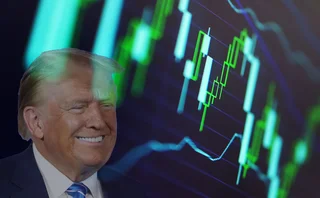
Now casting: options traders needed for disaster movie
Gamma deserves share of the spotlight in volatility drama
A cast of thousands will be required if someone makes a film of the February 5 surge in US equity market volatility.
There would be roles for central bankers who inadvertently encouraged investors to build short volatility positions; for structurers who created exchange-traded products (ETPs) to track the same bet, and retail investors who bought them; for workers whose rising wages first jolted stock markets on February 2; for asset managers who were shocked to see stocks falling at the same time bond yields were climbing; for commodity trading advisers, variable annuity insurers, and risk-parity funds that all had some exposure to a jump in volatility.
All have had at least a walk-on part in the research notes and articles that have appeared since two years of almost-uninterrupted calm was abruptly shattered.
One group, though, has been largely overlooked – bank options traders, whose gamma hedging also played a part in the eruption of volatility. The lack of attention may be because traders were too busy to speak to the press. It may be because the mysteries of gamma positioning are hard to explain and difficult to analyse. Or it may be because their influence was small – opinions differ on that point.
But let’s write them into the script anyway.
The outline is this: over the past 18 months, many institutional investors have chosen to express their short-vol view by selling downside protection in options form. In the middle of last year, analysts at Deutsche Bank estimated these unbalanced flows had given dealers their longest-ever gamma position.
Gamma is the rate of change of an option’s delta, while delta is the exposure to changes in the price of the underlying. When a dealer is long gamma, it will typically hedge on a daily basis by using linear instruments – for example, buying S&P 500 index futures when the market is down. That behaviour is self-reinforcing: it dampens realised volatility, making implied volatility look relatively expensive, and encouraging investors to sell it.
After helping create the conditions in which those products could flourish, the options desks would tear them to pieces in a half-hour orgy
How much of an impact did this behaviour have? Speaking prior to February 5, Kokou Agbo-Bloua, global head of flow strategy and solutions at Societe Generale Corporate & Investment Banking, estimated up to 60% of daily volatility trading was linked to dealer hedging.
Volatility was low in those months for a mix of fundamental reasons and supply-and-demand factors, he said: “But the reason we have been going to such low levels – that extra mile – is the gamma hedging by dealers.”
Now assume the average strikes of the options the dealers are long are all clustered around the same kind of level. If the market moves rapidly down, away from those levels – as it did on February 2, and again after the weekend – then the bank options desks stop being long gamma, and eventually end up short. At this point, they hedge further moves by trading the same way as the underlying – they sell when the market drops, or buy when it rises, serving to magnify those moves.
There is a lot of sympathy for the view that this added fuel to the fire on February 5 – but no-one knows precisely when the dealer position flipped, or what impact it had.
If this was Hollywood, though, that wouldn’t be an obstacle. In one of the film’s climactic scenes, gamma hedging from options desks would accelerate during the afternoon of February 5 – pushing the market against the short-Vix ETPs. After helping create the conditions in which those products could flourish, the options desks would tear them to pieces in a half-hour orgy.
Real life is rarely as simple as that, of course.
Only users who have a paid subscription or are part of a corporate subscription are able to print or copy content.
To access these options, along with all other subscription benefits, please contact info@risk.net or view our subscription options here: http://subscriptions.risk.net/subscribe
You are currently unable to print this content. Please contact info@risk.net to find out more.
You are currently unable to copy this content. Please contact info@risk.net to find out more.
Copyright Infopro Digital Limited. All rights reserved.
As outlined in our terms and conditions, https://www.infopro-digital.com/terms-and-conditions/subscriptions/ (point 2.4), printing is limited to a single copy.
If you would like to purchase additional rights please email info@risk.net
Copyright Infopro Digital Limited. All rights reserved.
You may share this content using our article tools. As outlined in our terms and conditions, https://www.infopro-digital.com/terms-and-conditions/subscriptions/ (clause 2.4), an Authorised User may only make one copy of the materials for their own personal use. You must also comply with the restrictions in clause 2.5.
If you would like to purchase additional rights please email info@risk.net
More on Our take
Why a Trumpian world could be good for trend
Trump’s U-turns have hit returns, but the forces that put him in office could revive the investment strategy
Roll over, SRTs: Regulators fret over capital relief trades
Banks will have to balance the appeal of capital relief against the risk of a market shutdown
Thrown under the Omnibus: will GAR survive EU’s green rollback?
Green finance metric in limbo after suspension sees 90% of top EU banks forgo reporting
Has the Collins Amendment reached its endgame?
Scott Bessent wants to end the dual capital stack. How that would work in practice remains unclear
Talking Heads 2025: Who will buy Trump’s big, beautiful bonds?
Treasury issuance and hedge fund risks vex macro heavyweights
The AI explainability barrier is lowering
Improved and accessible tools can quickly make sense of complex models
Do BIS volumes soar past the trend?
FX market ADV has surged to $9.6 trillion in the latest triennial survey, but are these figures representative?
DFAST monoculture is its own test
Drop in frequency and scope of stress test disclosures makes it hard to monitor bank mimicry of Fed models








